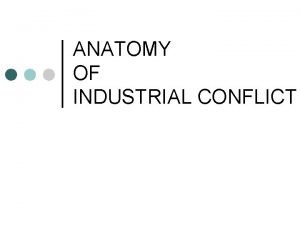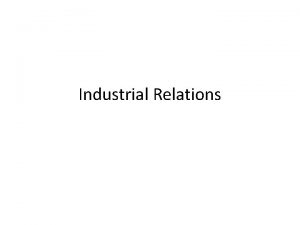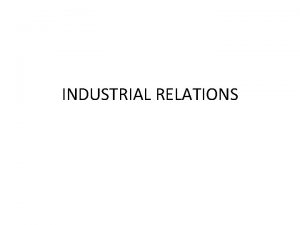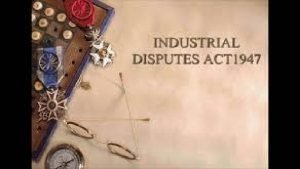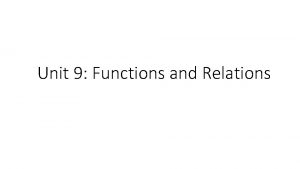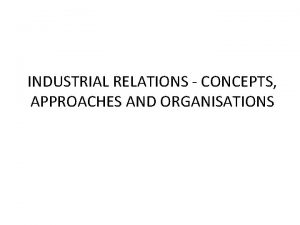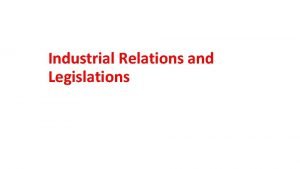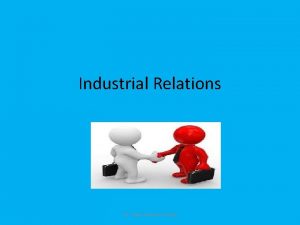Industrial Relations Unit 2 INDUSTRIAL DISPUTES INDEX CONCEPT














- Slides: 14

Industrial Relations Unit 2 INDUSTRIAL DISPUTES INDEX: CONCEPT DEFINITION CAUSES OF INDUSTRIAL DIPUTE BY SUMIT MANJHI

Concept & Definition of Industrial Dispute Industrial disputes in general are settled through the mechanism of collective bargaining at the initial stage. The failure of collective bargaining leads the disputes to the system of conciliation under the statutory compulsion. The Industrial Disputes Act 1947 under Section 2(K) defines the industrial dispute as "any dispute or difference between employers and employers or between employers and workmen or between workmen and workmen which is connected with the employment or non-employment or terms of employment or with the conditions of labour of any person. "

By incorporating Section 2 A in the Industrial disputes Act, 1947, a right has been given to an individual workman himself to raise an industrial dispute with regard to termination, discharge, dismissal or retrenchment of his service even though no other workmen nor any trade union(s) of workmen raised it (or) is a party to the disputes. The disputes filed by an individual workmen under Section 2 A of the Act are also construed as Industrial disputes as per Section 2(K) of the Act. The Supreme Court of India in the case of Standard Vacuum Refining Co. v/s Their workmen observed that the definition of 'Industrial Dispute' could be examined in the light of three factors: i) the 'FACTUM' (real or substantive fact concerning the dispute) ii) the PARTIES - to the dispute iii) the subject 'MATTER" - of the dispute

As whole the following conditions shall exist: (i) There shall be an industry (Section 2 (j) of the Industrial Disputes Act, 1947) (ii) There shall be a relationship between employer and workmen. (iii) Shall be connected with trade, business, manufacturing, undertaking, calling or production of material goods and services. (iv) The activity carried on to satisfy human wants and needs; however profit motive is immaterial. (v) The dispute shall be between, employer and employer or employer and workmen or workman and workmen. (vi) The dispute shall be connected with employment, non-employment, terms of employment or condition of labour. (vii) The dispute shall be connected with a workman or a group of workmen which has a direct or substantial interest. However, for an individual disputes (Section 2 A) the substantial support of workman or trade union is not essential.

Causes of Industrial Dispute We can classify the causes of industrial disputes into two broad groups: (i) Economic causes, and (ii) Non-economic causes. Economic causes include: (i) Wages, (ii) Bonus, (iii) Dearness allowance, (iv) Conditions of work and employment, (v) Working hours, (vi) Leave and holidays with pay, and (vii) Unjust dismissals or retrenchments.

Non-economic causes include: (i) Recognition of trade unions, (ii) Victimisation of workers, (iii) Ill-treatment by supervisory staff, (iv) Sympathetic strikes, (v) Political causes, etc. 1. Wages and Allowances: Since the cost of living has generally showed an increasing trend, the workers have been fighting for higher wages to meet the rising cost of living and to increase their standard of living. 34. 1% of the industrial disputes in 1973 were due to demand for higher wages and allowances. This percentage was 36. 1% in 1974. During 1985, 22. 5% of the disputes were due to wages and allowances. Wages and allowances accounted for 25. 7% of disputes in 1986, 26. 6% in 1992, 25. 0% in 1996 and 20. 2% in 2000.

2. Personnel and Retrenchment: Personnel and retrenchment causes have also been important. During 1973, 24. 3% of the industrial disputes were because of dismissals, retrenchment, etc. as compared to 29. 3% in 1961. In 1979, personnel and retrenchment topped the list of causes of industrial disputes with 29. 9%. The number of disputes because of personnel and retrenchment was 32. 0% in 1971, 23. 1% in 1985 and 19. 8% in 1996. In 2000, about 12. 1% of the disputes occurred due to dismissals, layoffs, retrenchments, etc. 3. Bonus: Bonus has been an important factor in the industrial disputes, 10. 3% of the industrial disputes in 1973 were because of bonus as compared to 6. 9% in 1961. 13. 8% and 15. 2% of the disputes were due to bonus during 1976 and 1977 respectively. It is worth noting that during 1982 only 4. 7% of the disputes were due to bonus as compared to 7. 3% in 1985. This percentage was 4. 2 in 1992, 3. 6 in 1996 and 8. 5 in 2000.

4. Indiscipline and Violence: The number of disputes because of indiscipline and violence among the workers has been significant. During 1987, 15. 7% of the disputes were because of indiscipline and violence as compared to only 5. 7% in 1973. During 1985, 16. 1% of industrial disputes were caused by indiscipline and violence and during 1996, about 21. 6% of the industrial disputes arose due to indiscipline and violence in industrial undertaking. This shows that indiscipline and violence have continued to be a serious problem in industry during the past two decades. 5. Leave and Hours of Work: Leave and hours of work have not been so important causes of industrial disputes. During 1973, 1. 5% of the causes were because of leave and hours of work. Their percentage share in the industrial disputes was 2. 2% in 1977, 1. 8% in 1985, 2. 2% in 1996 and 0. 9% in 2000.

6. Miscellaneous Causes: Miscellaneous causes include modernisation of plant and introduction of computers and automatic machinery recognition of union political factors, etc. These factors have caused a significant number of industrial disputes in the country, 24. 1% of the industrial disputes in 1973 were due to miscellaneous causes. They accounted for 19. 5% of the industrial disputes in 1977, 29. 2% in 1985, 27. 8% in 1996 and 33. 2% in 2000. 7. Miscellaneous causes of industrial disputes are as follows: (a) Workers’ resistance to rationalisation, introduction of new machinery and change of place of factory. (b) Non-recognition of trade union. (c) Rumours spread out by undesirable elements. (d) Working conditions and working methods. (e) Lack of proper communication. (f) Behaviour of supervisors. (g) Trade union rivalry etc.

(i) Adverse economic and political system. (ii) Intra and inter-union rivalries. (iii) Unfair labour practices. (iv) Interpretations of various sections of legislative framework. (v) Inadequate welfare measures. (vi) Excessive work load. (vii) Increased differences in sharing the gains of productivity. (viii) Lack of human relations approach. (ix) Unreasonable wages (x) Management attitude on labour.

(xi) Trade Union approach on management. (xii) Maltreatment and wrong penalising. (xiii) Lack of proper machinery for collective bargaining. (xiv) Indiscipline among workmen. (xv) Lack of close bond between workmen and management. (xvi) Illegal retrenchment, lay off and closures. (xvii) Illegal strikes and lock-outs. (xviii) Lack of proper policy on Trade Union recognition. (xix) Lack of compulsion on the Act to register all Trade Unions under the Trade Union Act, 1926. (xx) Absence of compulsory 'check off' system.

(xxi) Duplication of or dual membership in Trade Unions. (xxii) External leadership in Trade Unions. (xxiii) Multiplicity of Trade Unions in industries. (xxiv) Selfish approach of Trade Union leaders. (xxv) Denial of workers right to organise, right to express. (xxvi) Lack of involvement of workmen in activities of management. (xxvii) Declining work values and, work ethics

Thus, industrial disputes do not arise only when workers are dissatisfied on economic grounds, they also arise over issues which are of non-economic nature. Instances may be quoted when strikes where successfully organised to protest against the management’s decision to change the location of the plant from one state to another. Similarly, even causes like behaviour of supervisor and trade union rivalries may give rise to industrial disputes. The whole concept of industrial relations revolves around the principle of friction dynamics which is the key to the establishment of harmonious relations between labour and management. We cannot think of any society completely obliviant of some sort of friction between labour and management.

Thank You
 Anatomy of industrial disputes
Anatomy of industrial disputes Factors of industrial relations
Factors of industrial relations Examples of locational boundary disputes
Examples of locational boundary disputes Nicholas spykman rimland theory
Nicholas spykman rimland theory Allocational boundary dispute definition
Allocational boundary dispute definition Why might fishing disputes arise in the region?
Why might fishing disputes arise in the region? Chapter 4 settling disputes
Chapter 4 settling disputes Consumer disputes redressal agencies
Consumer disputes redressal agencies Consumer disputes redressal agencies
Consumer disputes redressal agencies Change order disputes
Change order disputes Employee relations in public relations
Employee relations in public relations Diff between step index and graded index fiber
Diff between step index and graded index fiber Primary index is dense or sparse
Primary index is dense or sparse Morphological index
Morphological index Compare india and sri lanka on the basis of hdi
Compare india and sri lanka on the basis of hdi
